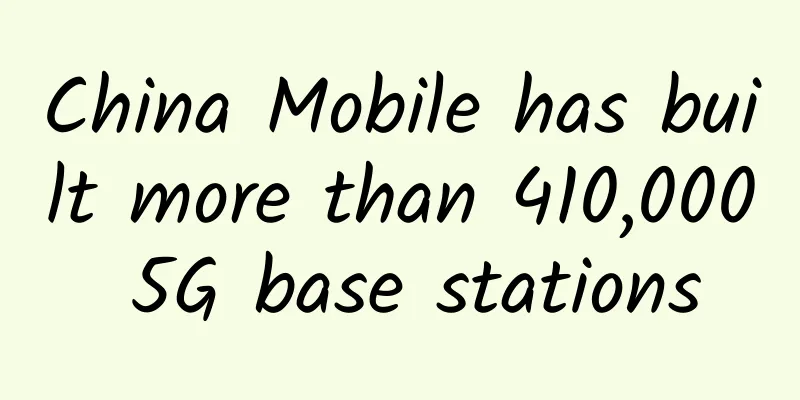Connecting the industrial ecosystem, 5G accelerates the empowerment of thousands of industries

|
As the saying goes, a single tree cannot make a forest. 5G is a huge system project. From research and development, standardization, engineering design, product launch to commercial implementation, it integrates the efforts of many industry practitioners. For 5G, which aims to empower the digitalization of thousands of industries and enable the development of a digital society, it is particularly important to create an open, cooperative and win-win industrial ecology. The industrial ecology of you in me and me in you has played a positive role and made great contributions in the formulation and evolution of 5G standards, accelerating terminal development, and empowering the industry. Working together to promote the continuous evolution of standardsFirst, let’s look at the standards. At present, the entire network construction is based on the first version of the international standard - 5G basic standard R15, which meets the enhanced mobile broadband scenario (eMBB) in the three major application scenarios of 5G, achieves faster network transmission rate, and is mainly aimed at the ToC market. It provides an overall architecture for the subsequent 5G development. R15 is the cornerstone of the future evolution of 5G. R16 focuses on perfect low latency and high reliability capabilities. R16 also introduces NR V2X for the first time and introduces 5G NR-based direct communication for C-V2X. These new features are key technologies in R16 to promote the expansion of 5G to vertical industries. At the 88th meeting of 3GPP TSG in July 2020, the 5G R16 standard was announced to be frozen, marking the official completion of the first evolution version of 5G standard. R17 is mainly aimed at medium-high-speed and large-connection IoT scenarios. In terms of spectrum, one of the extended features supported by R17 is to expand the millimeter wave frequency band from 52.6GHz to 71GHz; at the same time, R17 also introduces "NR-Light" (i.e. RedCap) for IoT terminals with lower complexity, non-terrestrial communication (NTN) i.e. satellite communication, and supports enhanced industrial IoT, positioning and V2X, as well as enhanced integrated access and backhaul (IAB) and RF repeaters. R18 opens the second stage of 5G, namely 5G-Advanced. R18 will bring all-round capability improvement: first, continuous enhancement of broadband to better support new services represented by XR, higher spectrum efficiency, better network coverage, and more energy-saving terminals; second, vertical industry support, strengthened integrated applications, more vertical industry-specific terminals, and enhanced vertical industry-specific scenarios (such as enhanced uplink capabilities, enhanced positioning, etc.); third, artificial intelligence integration to develop new resource dimensions; fourth, communication perception integration to stimulate new potential of 5G. On June 9, 2022, at the 96th 3GPP RAN meeting held in Budapest, Hungary, the 5G R17 standard was frozen, marking the official completion of the second evolution version (third version) of 5G standards. This not only means the successful completion of the first phase of 5G technology evolution, but also proves that the mobile "ecosystem" has strong resilience, providing a broader development space for 5G industry applications. In supporting the formulation and evolution of 5G standards, leading global operators, including Huawei, ZTE, Ericsson, Nokia Bell, Qualcomm and other leading global manufacturers have made extraordinary contributions. For example, operators are leading the industry in the evolution of 5G standards. On June 6, 2022, China Mobile and industry partners jointly released the world's first batch of 5G-Advanced end-to-end industry samples and the "5G-Advanced New Capabilities and Industry Development White Paper", marking the deep integration of the 5G-Advanced innovation chain and the industrial chain, and promoting 5G-Advanced into a new stage of industrial construction; on May 15, 2022, China Unicom released 5G-Advanced's three major smart series of technological innovations and practical results. In addition, Qualcomm, which has more than 30 years of investment and technology accumulation in the mobile communications industry, has participated in the entire process from 2G, 3G, 4G to 5G, and has worked with the industry ecosystem to assist in the formulation of R15, R16, and R17 standards, as well as the future evolution of R18, continuously promoting the development of 5G, and working with partners to promote the sustainable development of global wireless technology. On the equipment vendor side, for example, Ericsson, which has a history of 146 years, has been deeply involved in the entire process of mobile communication network construction from 1G to 5G, and in the 5G era has made important contributions to the establishment of a global unified 5G standard. 5G mobile phones are becoming more and more popular, thanks to chip supportIn the early stage of 5G commercialization, as the smart terminal form closest to consumers, 5G mobile phones have become the pioneers of 5G commercialization. Compared with the 4G era, 5G mobile phones have developed and matured faster. The latest report data released by market research firm Counterpoint Research shows that smartphones using 5G technology have accounted for 51% of global smartphone sales. In China, the number of 5G mobile phone models has increased significantly, the experience has been continuously improved, and the price has been continuously reduced, which has accelerated the popularization of 5G mobile phones. According to the latest report data from the China Academy of Information and Communications Technology, in May 2022, the Chinese market shipped 20.805 million mobile phones, of which 17.739 million were 5G mobile phones, a year-on-year increase of 6.0%, accounting for 85.3% of mobile phone shipments in the same period. As the core component of mobile phones, the rapid maturity of chips has become a key driving force for the popularization of 5G mobile phones and a prominent manifestation of the open cooperation of the 5G industry ecosystem. In the 5G era, the terminal chip market has been reshuffled. The only third-party chip suppliers left are Qualcomm, MediaTek, and Unisoc, three major players, as well as a few mobile phone companies such as Samsung and Apple that have the ability to develop their own chips. The research report "Baseband Market Share Tracking in Q4 2021: Qualcomm and MediaTek Together Grab 95% of 5G Market Share" by market research firm Strategy Analytics pointed out that in 2021, the global mobile phone baseband processor market revenue increased by 19.5% year-on-year to US$31.4 billion; among which 5G baseband revenue increased by 71% year-on-year, accounting for 66% of the total baseband revenue in 2021. Qualcomm, MediaTek, Samsung LSI, Unisoc and Intel occupied the top five positions in the baseband chip market revenue share in 2021, with Qualcomm leading the baseband chip market with a revenue share of 56%, followed by MediaTek (28%) and Samsung LSI (7%). Industry applications have achieved fruitful results, and all parties in the ecosystem have joined hands to accelerate deep integrationIf the ToC market is the foundation of 5G applications, then accelerating the digital transformation of vertical industries and boosting the development of the digital economy are the real goals of 5G. Ericsson predicts that by 2030, the economic revenue from the global digital transformation brought about by 5G will reach $1.5 trillion. According to the China Academy of Information and Communications Technology, 5G is expected to drive China's digital economy growth by 15.2 trillion yuan from 2020 to 2025. The integrated development of 5G and new ICT technologies such as artificial intelligence and big data will promote profound changes in the production organization mode, resource allocation efficiency, and management service model of the digital economy. Taking the Chinese market as an example, with the concerted efforts of all parties in the industrial ecosystem, the tentacles of 5G are extending to more industries and fields. In July 2021, the "5G Application "Sailing" Action Plan (2021-2023)" jointly issued by ten departments clearly stated that it is necessary to carry out in-depth integrated application actions in many sub-sectors. Public data shows that 5G is playing an enabling role in many industries in my country, such as industry, medical care, education, and transportation, forming a number of typical application scenarios with commercial value, covering 40 of the 97 major categories of the national economy, and deploying more than 5,325 5G industry virtual private networks. The development of 5G industry applications has entered the "fast lane", and applications in leading fields have begun to be replicated on a large scale. It should be pointed out in particular that, first, in the era of digital economy, the digitalization of thousands of industries requires high-performance network connections as the basic foundation; secondly, the complex, diverse and integrated new services and applications in the 5G era put forward higher requirements on the computing power of the core network, wireless network, edge side and terminals; in addition, 5G industry applications involve all aspects and often require cross-industry collaboration to complete. Therefore, the development of 5G applications has put forward higher requirements for open cooperation in the upstream and downstream of the industrial ecology. All parties need to work together to accelerate the deep integration of IT, CT, and OT, open up all links in the industrial chain, and build a good industrial ecology. More technologies and products are urgently needed for win-win cooperation between enterprises at the intersection of everything connected, enterprise digital transformation, and key industry trends. With its deep accumulation and technical expertise in the fields of connectivity, high performance, low-power computing, and terminal-side AI, Qualcomm has created a unified technology roadmap, bringing technical advantages such as AI, imaging, graphics processing, and connectivity to almost all types of networked terminals. It not only provides the industry with multiple generations of 5G solutions covering a wide range of terminal types, but also works closely with many Chinese companies to continuously accelerate the 5G commercialization process, application implementation, and ecological innovation through important initiatives such as the "5G Pilot Program", the "5G Internet of Things Innovation Program", and the establishment of a 5G Ecosystem Venture Capital Fund. Looking to the future, we hope that the industry will continue to use innovative technologies such as 5G as a ladder to build an open innovation ecosystem and accelerate the realization of the beautiful vision of a digital society. |
<<: Six years after LPWAN became popular, what happened to non-cellular IoT technologies?
>>: What can digital twins bring to wireless communications?
Recommend
DMIT's new San Jose data center starts at $36.9/year, 15% off + free data
DMIT.io opened a new data center in San Jose, USA...
HostDare: 25% off NVMe VPS in Los Angeles starting at $19.5/year
I received the latest promotional email from Host...
[Black Friday] RackNerd: VPS starts at $10.18/year, dedicated servers start at $59/month, multiple data centers in Los Angeles/San Jose/Utah, etc.
Just after Double Eleven, RackNerd released Black...
Mobile networks want to kill WiFi, but it won’t work in China
According to a recent report by OpenSignal Mobile...
Building a cloud foundation to connect the world | Ruijie Networks presents cutting-edge products at the 2021 PT Expo
On September 27, 2021, the 30th China Internation...
2021 is the year of the explosion of the cellular IoT module industry
According to a new research report from IoT analy...
An article reveals the practice and thinking of edge computing reference architecture 2.0
[51CTO.com original article] With the development...
Network security experts teach you how to set up the most secure WiFi password in history
By setting a strong password, you can prevent WiF...
Five API Gateway Technology Selections, yyds
This article intends to discuss gateways around s...
Calculation of IP address and subnet mask
Each device connected to the network needs a uniq...
How to determine whether the protocol is Websocket in Http Header
[[398343]] This article is reprinted from the WeC...
What problems does each generation of HTTP protocol solve?
Recently, I briefly studied the development histo...
After the construction of 5G, 4G Internet access on mobile phones has become slower. Is this really a marketing trick of the operators?
Preface [[332244]] Recently, many customers and f...
SpartanHost: Seattle AMD Ryzen/E5 series large-scale replenishment, 10Gbps port high-defense host starting at $3.5/month
SpartanHost is a foreign hosting company founded ...
5G will change the world. What does it mean for regulations?
The Fourth Industrial Revolution will see the lin...









